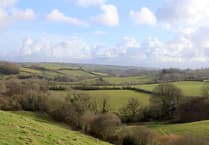JUST off the A3072 a few hundred yards east of Holsworthy town centre lies one of the so-called ‘underground nuclear bunkers’.
Dr Philip Kivell whose sister formerly owned the site, has shared some information and his own recollections of the bunker with the Post.
This location, on a spur of land some 540 feet above sea level, commands clear views in all directions and for many years it has been a significant location for the area. Originally it was the location of a windmill, hence the name Windmill Road, but this fell into disuse and had gone by the end of the 19th century.
During World War Two the location, with its excellent lines of sight, made it an obvious choice for an aircraft observation and tracking station. A basic structure was built, mainly of wood, with an upper storey that was glass fronted on all sides providing an elevated viewing platform. This was staffed by the Royal Observer Corps (ROC), which was the ‘eyes and ears of the RAF’. Dr Kivell said: “I certainly remember playing around this structure as a small boy in the early 1950s, although it was in a precarious state by then.”
After the war the ROC’s role was less vital and their observation post on Windmill Hill slowly collapsed.
With the onset of the Cold War in the 1950s new threats to Britain’s security began to emerge and in particular there was now a nuclear age to contend with. Tracking and plotting aircraft became increasingly difficult for the ROC as jet aeroplanes flew higher and faster, but monitoring the possible effects of nuclear explosions and the spread of radioactivity gave the organisation a vital new role. The decision was therefore taken in the mid-1950s to construct a network of underground monitoring posts.
Dr Kivell said: “For many years our family had farmed and owned the field in which the Holsworthy post was built and as a teenager I was fascinated to watch the excavation and building in the early months of 1960. A large hole was dug at the highest point of the field and a single concrete chamber, with thick walls and roof, was constructed at a depth of no more than 15 or 20 feet. I remember being impressed by the fact that it was given a thick coat of damp-proofing bitumen. When the chamber was covered a series of air vents and instrument conduits penetrated the surface and a small concrete hut was built at ground level. This had a telephone link and an instrument table to assist visual plotting. The whole plot measured about 20 yards square and it was surrounded by a stock-proof fence.”
The Holsworthy site was completed in June 1960 and became part of a network that eventually totalled over 1,500 posts across the UK. Normally these posts were around eight to ten miles apart and others were built locally at Hatherleigh, Week St Mary, Kilkhampton, Launceston and Otterham and there was a regional HQ at Bristol. Their main purpose was to report any nuclear explosions and monitor fall out. They were usually staffed by up to three people. Dr Kivell said in theory they could be occupied for a week or two but in practise it was usually a case of evening or weekend duties: “On more than one occasion members of the ROC trying to gain access to the bunker claimed to have been intimidated by our cattle but invariably the latter were being inquisitive rather than dangerous!”
With the easing of Cold War tensions and the rise of ever more sophisticated monitoring equipment, including satellites, the role of the ROC diminished. The monitoring posts were now largely redundant and the Holsworthy post was decommissioned in 1991.
Following its closure the bunker was offered to the Kivell family for sale, Dr Kivell said: “Upon the closure of the post the MOD offered it to us as the owners of the surrounding land. We purchased it, not because we had a use for it but mostly to maintain the integrity of the field and minimise access issues with any third party purchaser. When it came into our possession I had a chance to inspect it inside as well as outside. It consists of a single main room about 15ft x 7ft and about 7ft high and a very small room for a chemical lavatory. Access is through a steel trapdoor and then down a vertical metal ladder about 20ft to the bottom of a narrow shaft. There is no mains water or power source and the room is cramped and cold. Originally there would have been a couple of bunk beds, a telephone link and an array of measuring instruments but these had been removed when the post was closed. We secured the access shaft with two heavy duty padlocks but these were repeatedly cut off and the area subject to vandalism. Eventually we had the access door welded shut, not because there was anything left that was worth stealing but because we feared that if anybody broke into the site and was injured it could present us with a moral, and possibly, a legal dilemma.”
In December 2014 the Kivell family put the field and underground post up for auction at Holsworthy Livestock Centre where it was purchased by a private buyer. The current owners are as yet unknown.




